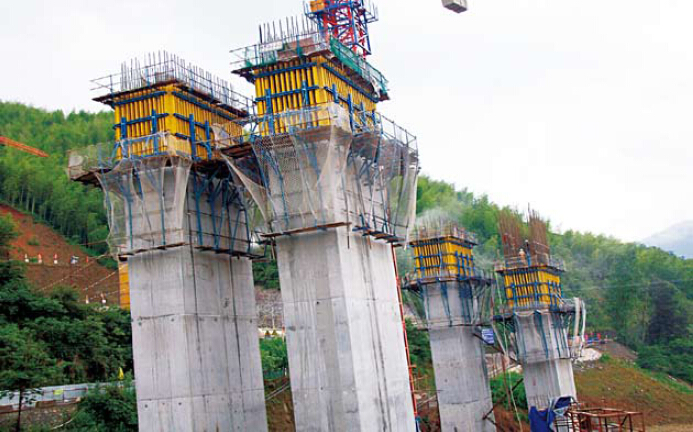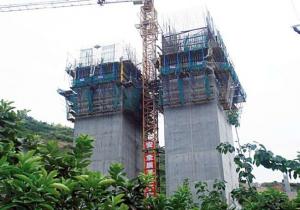Climbing-Bracket for formwork and scaffolding system
- Loading Port:
- Tianjin
- Payment Terms:
- TT OR LC
- Min Order Qty:
- 50 m²
- Supply Capability:
- 1000 m²/month
OKorder Service Pledge
OKorder Financial Service
You Might Also Like
Climbing Bracket CB240 & CB210
They are framework brackets for supporting large-area wall formwork.
Typical applications for the CB240&CB210 are pier and column/shear wall/core walll/ in the
building.
CB210 has smaller size than CB240, it will be cost effective in some condition.
Characteristics:
◆ High bearing capacity
The high loading capacity of the brackets allow very large scaffold units. This saves the number
anchor points required as well as reducing climbing times.
◆ Simple moving procedure by crane
Through the strong connection of formwork together with the climbing scaffold, both can be moved
as a single climbing unit by crane. Thus valuable time-savings can be achieved.
◆ Fast striking process without a crane
With the retrusive set, large formwork elements can also be retracted quickly and a minimum of
effort.
◆ Safe with work platform
The platforms have assembled firmly with bracket and will be climbing together, without scaffolding
but can work safely in spite of your high location.


- Q:How does steel formwork affect the overall labor productivity in construction?
- Steel formwork can have a significant impact on labor productivity in construction. Firstly, steel formwork is known for its durability and strength, which allows it to withstand the pressures and forces exerted during the concrete pouring process. This reduces the need for frequent repairs or replacements, minimizing downtime and increasing overall labor productivity. Additionally, steel formwork offers a high level of accuracy and precision in creating concrete structures. This results in better quality finishes and reduces the need for rework or corrections, saving time and effort for construction workers. The ability to achieve consistent dimensions and smooth surfaces with steel formwork also enhances the overall efficiency of the construction process. Furthermore, steel formwork is known for its ease of assembly and dismantling. The modular nature of steel formwork systems allows for quick and efficient setup, reducing the time spent on formwork erection. Similarly, the ease of dismantling enables faster turnaround times between construction phases, allowing workers to progress to the next task more swiftly. Moreover, steel formwork systems often incorporate features such as adjustable props, clamps, and connectors, making them highly adaptable to various construction requirements. This versatility enables workers to quickly adjust and modify the formwork to accommodate changes in design or construction plans, eliminating delays and improving labor productivity. Lastly, steel formwork can contribute to a safer working environment. The robustness and stability of steel formwork systems offer enhanced protection for construction workers, reducing the risk of accidents and injuries. By ensuring worker safety, steel formwork promotes a more efficient and productive construction process. In summary, steel formwork positively impacts labor productivity in construction by providing durability, accuracy, ease of assembly and dismantling, adaptability, and improved safety. These factors contribute to a more efficient construction process, reducing downtime, rework, and the overall time required for project completion.
- Q:Can steel formwork be used for architectural concrete beams?
- Yes, steel formwork can be used for architectural concrete beams. Steel formwork offers several advantages over traditional wooden formwork, such as increased durability and reusability. Steel formwork is stronger and more rigid, allowing for precise and accurate construction of architectural concrete beams. It also provides a smooth and consistent surface finish, which is important for achieving the desired aesthetic appearance of the beams. Additionally, steel formwork can be easily assembled, disassembled, and transported, making it a practical choice for architectural concrete beam construction.
- Q:Production of steel plate for bridge steel plate SPHC and Q235 which material is good? What is the difference?
- Equivalent to GB GB699 (high quality carbon structural steel national standard) in the 10#, 15# steel hot-rolled plate, their carbon content range is about 0.1-0.15%.Q235 is the national standard GB700 (carbon structural steel national standard)
- Q:What are the different types of finishes available for steel formwork?
- There are several different types of finishes available for steel formwork, each offering unique advantages and characteristics. Some of the most common finishes include: 1. Smooth finish: This is the most basic type of finish, where the steel formwork is left untreated. It provides a clean and smooth surface, making it suitable for applications where a smooth concrete finish is desired. 2. Galvanized finish: Galvanizing involves coating the steel formwork with a layer of zinc to protect it from corrosion. This finish is highly durable and can withstand harsh weather conditions, making it ideal for outdoor applications. 3. Powder-coated finish: Powder coating involves applying a dry powder to the steel formwork and then baking it on. This finish provides a decorative and durable coating that is resistant to chipping, scratching, and fading. It is available in a wide range of colors, allowing for customization. 4. Painted finish: Painting the steel formwork is another common option. It provides protection against corrosion and enhances the aesthetics of the formwork. Different types of paints, such as epoxy or acrylic, can be used depending on the specific requirements of the project. 5. Shot-blasted finish: Shot blasting involves projecting small steel shots onto the surface of the formwork at high velocity. This process removes any impurities, rust, or old coatings, resulting in a clean and textured finish. Shot blasting is commonly used when a rough surface is desired for better adhesion of the concrete. 6. Treated finish: Some steel formwork can be treated with special coatings or chemicals to enhance their properties. For example, anti-stick coatings can be applied to prevent concrete from adhering to the formwork, making it easier to remove after curing. Other treatments may include rust inhibitors or fire-resistant coatings. The choice of finish for steel formwork depends on various factors such as the intended use, environmental conditions, desired aesthetics, and budget. Consulting with a professional or manufacturer can help determine the most suitable finish for a specific project.
- Q:What are the typical deflection limits for steel formwork systems?
- The typical deflection limits for steel formwork systems vary depending on the specific project requirements and design specifications. However, a common industry standard is to limit the deflection of steel formwork systems to be within 1/360th of the span length. This ensures structural integrity and minimizes any potential issues during the construction process.
- Q:How does steel formwork contribute to the accuracy of concrete placements?
- Steel formwork contributes to the accuracy of concrete placements by providing a strong and stable structure that holds the concrete in place during the pouring and setting process. The use of steel formwork ensures that the concrete is poured into the desired shape and dimensions, eliminating any potential for deviations or errors. Additionally, the rigid nature of steel formwork prevents any movement or shifting of the concrete, resulting in a more precise and accurate placement.
- Q:Can steel formwork be used in earthquake-prone areas?
- Indeed, in earthquake-prone areas, steel formwork proves to be a viable option. Due to its robustness and endurance, steel can withstand the immense forces generated during an earthquake. Its tensile strength is exceptional, enabling it to resist deformation or collapse when subjected to seismic loads. As a result, steel formwork systems are intentionally constructed to be rigid and stable, providing a secure and dependable solution for erecting buildings and structures in regions susceptible to earthquakes. Additionally, the reusability of steel formwork makes it an economically advantageous choice for construction projects in these locations. Nevertheless, it is imperative to ensure that the design and installation of the steel formwork adhere to the specific seismic requirements and regulations of the particular area, thus guaranteeing the utmost safety.
- Q:Can steel formwork be used in seismic-prone areas?
- Yes, steel formwork can be used in seismic-prone areas. Steel is a strong and durable material that can withstand the forces generated during earthquakes. It provides excellent structural stability and can be easily reinforced to meet the specific requirements of seismic design codes. Additionally, steel formwork offers the advantage of being reusable, making it a cost-effective and practical option for construction projects in seismic-prone areas.
- Q:What are the safety considerations when working with steel formwork?
- When working with steel formwork, there are several safety considerations that should be taken into account. First and foremost, workers must ensure that the formwork is properly installed and secured to prevent any collapse or instability. It is essential to follow manufacturer's instructions and guidelines for assembly and disassembly. Additionally, workers should be equipped with proper personal protective equipment (PPE) such as hard hats, gloves, and safety glasses to protect themselves from potential hazards such as falling objects or metal shards. Adequate training and supervision are also crucial to ensure that workers are aware of the potential risks and hazards associated with steel formwork and know how to work safely. Regular inspections of the formwork should be conducted to identify any signs of damage or deterioration that could compromise its structural integrity. Finally, proper communication and coordination among the team members is essential for a safe working environment when using steel formwork.
- Q:Are all steel plates used for beam slab prefabrication
- Should be determined according to the shape of the prefabricated components, specifications, to facilitate construction, cost savings, to ensure the quality of the premise.
1. Manufacturer Overview |
|
|---|---|
| Location | |
| Year Established | |
| Annual Output Value | |
| Main Markets | |
| Company Certifications | |
2. Manufacturer Certificates |
|
|---|---|
| a) Certification Name | |
| Range | |
| Reference | |
| Validity Period | |
3. Manufacturer Capability |
|
|---|---|
| a)Trade Capacity | |
| Nearest Port | |
| Export Percentage | |
| No.of Employees in Trade Department | |
| Language Spoken: | |
| b)Factory Information | |
| Factory Size: | |
| No. of Production Lines | |
| Contract Manufacturing | |
| Product Price Range | |
Send your message to us
Climbing-Bracket for formwork and scaffolding system
- Loading Port:
- Tianjin
- Payment Terms:
- TT OR LC
- Min Order Qty:
- 50 m²
- Supply Capability:
- 1000 m²/month
OKorder Service Pledge
OKorder Financial Service
Similar products
New products
Hot products

























